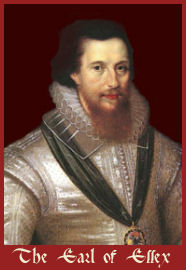
Patronage: Retinue, Companions, and Livery
Men
Young men go to Court to find a patron. Any of the great nobles draws such gentlemen to him in an essentially feudal relationship, based on personal loyalty, service, gifts, and favors.
These can include knights and younger sons, often with substantial incomes of their own. They might instead be scholars, musicians, and intellectuals, depending on the lord's inclinations.
Some of the gentry put their sons into great homes for their education and advancement.
Retainers, companions, or personal attendants are not necessarily poor relations. The earl of Essex has a knight in his train worth £1,000 per year!
Some of these companions are the armed (and often dangerous) men who go everywhere with their patron, to back him in a quarrel or simply to be there for the party.
The lord maintains them, pays them a fee (wages or favors), puts them in his livery, and gives them nominal positions in the household such as gentleman or yeoman usher.
Their main function is to increase the prestige of the patron while putting themselves in the way of advancement.
Women
A noble lady draws her waiting women from her relatives (and/or her husband's) and the daughters of the local gentry.
She helps her unmarried girls of good family to find suitable marriages and introduces them at Court. If they marry any of the Earl's followers, they may stay in attendance upon the Countess.
A great lady's gentlewomen join her in sewing, minding the older children, dispensing charity in the neighborhood, nursing the household. They also take charge of her clothing, jewelry, etc.
The Queen's Maids of Honor are (or should be) in this same client relationship to the Queen. They are her servants; she looks after their future. She is supposed to be finding them good husbands.
Livery
A nobleman provides livery for his servants in both summer and winter weights and sometimes variant colors. Sir William Petre put his household in blue for summer and a marbled grey for winter.
Livery can mean uniform clothing, or a badge of the lord's family on the sleeve, or a cloak in the lord's colors with the livery badge on the shoulder. The Earl of Southampton gave his followers each a gold chain as their livery token.
If you take a nobleman's livery (sometimes called taking his cloth) you become his follower (that is, his servant) and you owe him loyalty and other services as required.
You also share his exemption from certain laws. Peers cannot be arrested except for treason, felony, or breach of the peace, and neither can anyone in their livery. They cannot be put to torture without being attainted first.
A statute in every Tudor reign forbade the wearing of livery by any but household servants, to discourage factional fighting and the build up of private armies. For a while this threatened the freedom of liveried actors.
![]() Precedence, Preferment, & Attainder
Precedence, Preferment, & Attainder
![]() Ranks & Files
Ranks & Files
![]() The Senior Peers
The Senior Peers
![]() The Noble Style
The Noble Style
![]() Honor & Dueling
Honor & Dueling
![]() Ladies of Honour
Ladies of Honour





8 March 2010 mps
